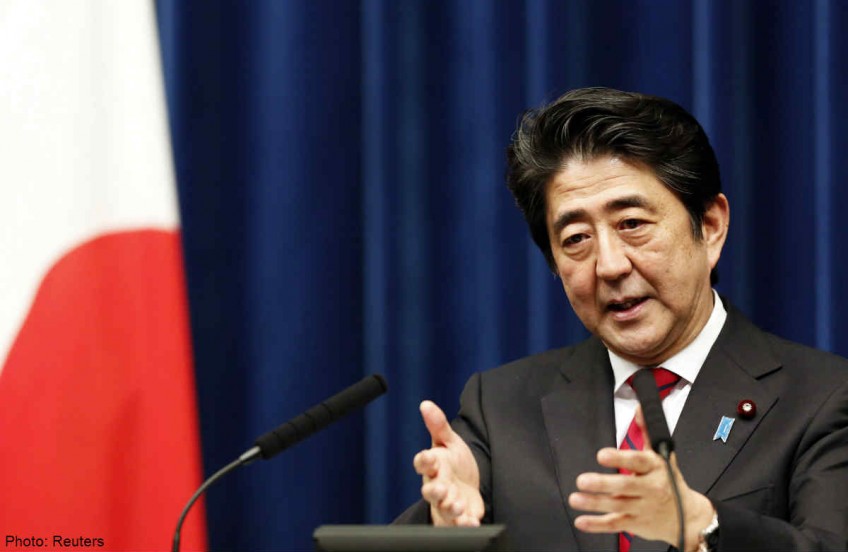Abe's LDP tables collective defence scenarios

The ruling Liberal Democratic Party (LDP) has drawn up eight possible scenarios said to require Japan to exercise the right to collective self- defence.
The LDP tabled the scenarios in talks with its junior coalition partner, New Komeito party, which it hopes will approve at least one of the eight.
New Komeito's approval would give Prime Minister Shinzo Abe enough justification to seek a Cabinet decision allowing a reinterpretation of the Constitution and thus give Japan its long self-denied right to collective self-defence.
Though not explicitly stated, the eight scenarios were apparently drawn up with the North Korean missile threat in mind.
One scenario involves protecting US warships that are targeted by ballistic missile launches. Another involves Japanese troops taking part in international minesweeping activities. But Mr Abe's favourite scenario - one that he harped on during a press conference on May 15 - involves the protection of US military transport ships evacuating Japanese nationals from a foreign country. He insists that the Japanese military cannot offer such protection without the right of collective self-defence.
In a pitch to the nation that day, Mr Abe had said: "You, or your children or your grandchildren may be in that place. I and the government have the responsibility to protect all your lives. Is it all right for us to be able to do nothing?"
The eight scenarios are part of a set of 15 that were shown to the New Komeito ahead of the two parties' meeting yesterday.
But reports said the eight scenarios were not touched on as the talks failed to move beyond discussion of three so-called "grey zone" situations. As these are scenarios in which war with another country has not broken out, it would be difficult for the Japanese police or the coast guard to deal with the situation under existing laws governing their present roles and capabilities.
The LDP had hoped to get the three grey zones out of the way quickly so that talks could move on to the eight scenarios.
But during discussion of one grey zone involving the retaking of remote Japanese islands occupied by foreign militants, the New Komeito insisted on knowing what the government would do should the disputed Senkaku islands - which the Chinese call Diaoyu and lay claim to - are illegally occupied. In the end, no agreement was reached on the three grey zones.
Talks will resume next Tuesday.
As part of his desire to revamp Japan's post-war security framework, Mr Abe is seeking to reinterpret the country's pacifist Constitution to give Japan the right to collective self-defence. But the New Komeito is opposed to such a drastic change in the nation's post-war security policy. New Komeito officials say many of the 15 scenarios can, in fact, be dealt with under Japan's existing individual self-defence capability or by expanding the authority of the police.
Japan is currently barred from conducting joint military operations with another country, including its security ally, the United States.
Although Mr Abe insists that there is no time limit for the coalition talks, he is believed to be hoping to wrap up the issue by June 22, when the current session of Parliament ends.
He is also up against the public, two-thirds of whom believe his desire to change the Constitution through a reinterpretation is an "improper" procedure.
In an interview with The Wall Street Journal, Mr Abe admitted that the issue was "difficult" for the people to understand and that there was "strong opposition".
Eight scenarios involving collective self-defence
-Protecting US transport vessels carrying Japanese nationals.
-Protecting US warships under attack.
-Forcibly stopping and searching ships.
-Firing at missiles that cross Japanese airspace and are headed towards the US.
-Protecting US warships on alert for ballistic missile launches (in the event of an emergency in areas surrounding Japan).
-Protecting US warships operating near Japan after an armed attack on the US mainland.
-Participating in international minesweeping activities.
-Participating in international efforts to protect civilian ships.
wengkin@sph.com.sg

This article was first published on May 28, 2014.
Get a copy of The Straits Times or go to straitstimes.com for more stories.